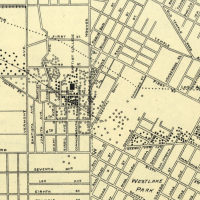The Convoluted Logic of L.A.'s Numbered Avenues

The following post is republished in partnership with USC Libraries.
There's an obvious logic to Manhattan's numbered street grid. Name any intersection of a numbered avenue and street — 57th and Fifth, for instance — and you immediately know its location on the island, and its distance from any other numbered crossroads.
Los Angeles also offers the urban navigator a set each of sequentially numbered streets (1st through 266th) and avenues (16 through 67, always expressed in cardinal, not ordinal terms), and yet their logic is not as evident as Manhattan's. Streets never intersect with avenues — though avenues sometimes intersect with each other, or dead-end in a hillside only to reappear a half-mile away — and avenues 1 through 15 are mysteriously absent. (To add to the confusion, numbered grids in places like Venice, San Pedro and Leimert Park survive as remnants of older subdivisions, originally plotted outside L.A.'s municipal boundaries and only later annexed to the city.)
The architects of this chaos intended something more methodical. When it convened in 1896, a special city commission sought to impose order on a sprawling grid of Northeast Los Angeles streets whose names often duplicated and sometimes triplicated each other. City maps had featured consecutively numbered streets since 1849, and the sequence had recently been extended to the southern city limit. Now the commission proposed a mirror sequence of "ways" (soon corrected to "avenues") north of the old Spanish plaza, overwriting old street names.




After contentious debate, the city council adopted the proposal on February 23, 1897. For a time, wayfaring through Los Angeles was improved. The duplicated names that once disoriented residents and tourists alike were eliminated; one of the city's three Walnut Streets became Avenue 20, and a second Avenue 52. And although the streets and avenues never intersected to create coordinates, they did helpfully count the blocks along the city's then-dominant north-south, Pasadena-San Pedro axis. Still, there were limitations. For one, property owners on the west bank of the Los Angeles River preferred the old names, so the avenues began on the east side, with 16. More consequentially, as urban development later spilled over Mount Washington and into the ravines of Highland Park, the grid folded onto itself so that numbered avenues, meant to run parallel, instead intersected, thus confusing the logic of a once-orderly scheme.




